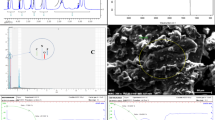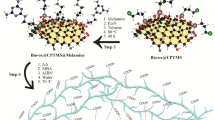Abstract
In this study, the removal of Reactive Red 195 (RR195) from an aqueous solution was carried out using poly(dimethylaminoethyl methacrylate-co-hydroxyethyl methacrylate) (PD-CO-H) as a polymeric adsorbent. The effects of the parameters of the adsorption process including sorbent dosage, pH, mixing time and initial concentration of dye were studied. The optimum values for each of them were 0.14 g L–1, 2, 150 rpm, and 10 mg L–1, respectively. In the optimum conditions, the removal efficiency was 100%. In order to determine the thermodynamic parameters of the process including enthalpy, entropy and Gibbs energy, the process was studied at three different temperatures of 298, 308, and 318 K, providing the values of 35.24 kJ, 0.159 kJ K–1, and –12.30 kJ for thermodynamic parameters, respectively. The kinetic study shows that the adsorption processes has pseudo-first-order and can be described by Langmuir isotherm. The result of the FTIR spectrometry for PD-CO-H, RR195, and PD-CO-H/RR195 verified the efficiency of the treatment. Also, the adsorbent was studied by SEM.





Similar content being viewed by others
REFERENCES
N. Sivaram, P. Gopal, and D. Barik, in Energy from Toxic Organic Waste for Heat and Power Generation (Elsevier, Amsterdam, 2019), p. 43.
F. I. Hai, K. Yamamoto, and K. Fukushi, Crit. Rev. Environ. Sci. Technol. 37, 315 (2007).
Q. Husain, Crit. Rev. Biotechnol. 26, 201 (2006).
A. Saeed, M. Iqbal, and S. I. Zafar, J. Hazard. Mater. 168, 406 (2009).
S. Jose, L. Samant, A. Bahuguna, and P. Pandit, Recycling from Waste in Fashion and Textiles: A Sustainable and Circular Economic Approach (Wiley, New York, 2020), p. 73.
R. Marandi, M. E. Olya, M. Khosravi, and R. Khalilnezhad, J. Appl. Environ. Biol. Sci. 3, 71 (2013).
V. Gupta, J. Environ. Manage. 90, 2313 (2009).
M. Olya, A. Aleboyeh, and H. Aleboyeh, Prog. Color. Color. Coat. 5, 41 (2012)
A. Shehata, Int. J. Emerging Technol. Adv. Eng. 3, 507 (2013).
W. Zhang, L. Ding, J. Luo, M. Y. Jaffrin, and B. Tang, Chem. Eng. J. 302, 446 (2016).
W. Qasim and A. Mane, Water Res. Ind. 4, 1 (2013).
F. Rahman and M. Akter, Int. J. Waste Res. 6, 2 (2016).
G. Vijayakumar, R. Tamilarasan, and M. Dharmendirakumar, J. Mater. Environ. Sci. 3, 157 (2012).
C. Zaharia, Int. J. Mater. Prod. Technol. 50, 196 (2015).
N. K. Amin, J. Hazard. Mater. 165, 52 (2009).
V. Gomez, M. Larrechi, and M. Callao, Chemosphere 69, 1151 (2007).
F. B. AbdurRahman, M. Akter, and M. Z. Abedin, Int. J. Sci. Technol. Res. 2, 47 (20013).
R. Ansari, Z. Mosayebzadeh, M. B. Keivani, and A. Khah, J. Adv. Sci. Res. 2, 27 (2011).
M. E. Argun, S. Dursun, M. Karatas, and M. Gürü, Biores. Technol. 99, 8691 (2008).
D. Shirsath and V. Shrivastava, Afr. J. Environ. Sci. Technol. 6, 115 (2012).
N. M. Mahmoodi, F. Najafi, and A. Neshat, Ind. Crops Prod. 42, 119 (2013).
Q. Sun and L. Yang, Water Res. 37, 1535 (2003).
W. Liu, C. Yao, M. Wang, J. Ji, L. Ying, and C. Fu, Environ. Prog. Sustain. Energy 32, 655 (2013).
S. Umoren, U. Etim, and A. Israel, J. Mater. Environ. Sci. 4, 75 (2013).
A. Srinivasan and T. Viraraghavan, J. Environ. Manage. 91, 1915 (2010).
I. K. Pathiraja, Dissertation (Southern Illinois Univ., Edwardsville, 2014).
P. V. Messina and P. C. Schulz, J. Colloid Interface Sci. 299, 305 (2006).
C. Namasivayam and R. Yamuna, Environ. Pollut. 89, 1 (1995).
ACKNOWLEDGMENTS
The authors did not receive support from any organization for the submitted work.
Author information
Authors and Affiliations
Corresponding author
Ethics declarations
The authors declare that they have no conflicts of interest.
Rights and permissions
About this article
Cite this article
Samali, N., Sadeghi, N., Abhari, F.M. et al. Synthesis of Poly[dimethylaminoethyl Methacrylate–Hydroxyethyl Methacrylate] As an Adsorbent for Removal of RR195 from Synthetic Effluent: Kinetic and Thermodynamic Study. Russ. J. Phys. Chem. 96, 397–406 (2022). https://doi.org/10.1134/S0036024422020200
Received:
Revised:
Accepted:
Published:
Issue Date:
DOI: https://doi.org/10.1134/S0036024422020200




